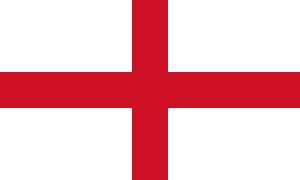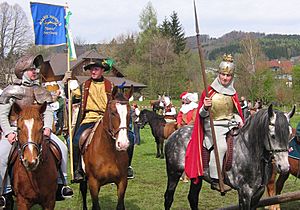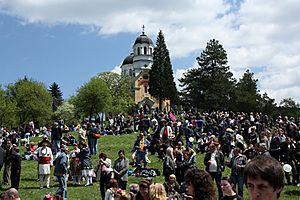Saint George's Day facts for kids
Quick facts for kids Saint George's Day |
|
|---|---|
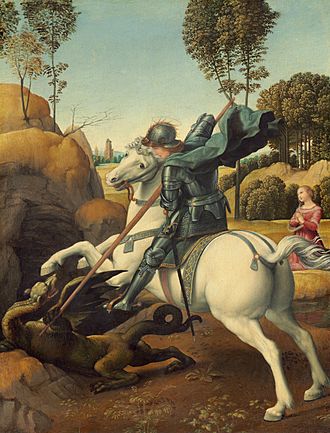
Saint George and the Dragon
Oil painting by Raphael (1505–1506) |
|
| Observed by |
Churches
Countries and Regions
|
| Type | Feast day; national day of England, regional day of Aragon. |
| Observances | Church services, flying of the St. George's Cross |
| Date | 23 April, 24 April, 6 May, 23 November, 25 January |
| Frequency | Annual |
| Related to | George's Day in Spring George's Day in Autumn Catalan Sant Jordi English Saint George's Day Đurđevdan Feast of Saint George |
Saint George's Day is a special day that celebrates Saint George. Many Christian churches, countries, and cities honor him because he is their patron saint. This includes places like Bulgaria, England, Georgia, Portugal, Romania, and parts of Spain like Aragon and Catalonia.
People usually celebrate Saint George's Day on April 23. This date is believed to be the day Saint George died during a time when Christians were persecuted.
Contents
When is Saint George's Day Celebrated?
Most Lutheran, Anglican, and Catholic churches celebrate Saint George's Day on April 23. However, if April 23 is too close to Easter, the celebration might move to a different weekday. This happens because Easter is a very important Christian holiday.
For example, in 2022, Saint George's Day was celebrated on April 26 in England and Wales. This was because April 23 was too close to Easter.
Some Eastern Orthodox Churches also celebrate Saint George's Day on April 23. But if it falls during Holy Week or on Easter, they move it to the Monday after Easter.
The country of Georgia celebrates Saint George's Day on April 23 and also on November 23. The Russian Orthodox Church has a special celebration on December 9.
Western Traditions for Saint George's Day
English Celebrations
Saint George has been important in England for a very long time. Records show him being mentioned as early as the 7th century. In the 1400s, Saint George's Day became a major holiday in England, similar to Christmas. People were not allowed to work, and they had to go to church.
King Edward III (who ruled from 1327 to 1377) created the Order of the Garter. This is a very important group of knights, and it is dedicated to Saint George. The badge of the Order shows Saint George riding a horse and fighting a dragon. During the Hundred Years' War, English soldiers would even shout Saint George's name as a battle cry.
Over time, the celebrations for Saint George's Day became less common, especially after England and Scotland joined together. However, in recent years, more people are starting to celebrate it again. Some people want it to be a public holiday once more.
On Saint George's Day, it's common to see the St. George's Cross flag flying. Many pubs and buildings are decorated with these flags. People also often sing the hymn "Jerusalem" in churches.
Saint George is also the patron saint of The Scout Movement. Scouts around the world often hold parades on Saint George's Day.
Celebrations in Spain and Portugal
Saint George is a very important saint in the former Crown of Aragon in Spain. King Peter I made him the patron saint after winning a big battle in 1096.
In Aragon, April 23 is "Día de Aragón" (Day of Aragon). It celebrates the Battle of Alcoraz, where Saint George is said to have helped the Christian army win.
In Catalonia, April 23 is called la Diada de Sant Jordi. It's a bit like Valentine's Day. Boys traditionally give girls a red rose, and girls give boys a book. You can see many books for sale on the streets!
In the city of Alcoi in Spain, Saint George's Day is a huge festival. People dress up in medieval costumes as "Moors and Christians" and act out a battle. This celebrates Saint George's help during a siege of the city.
In Caceres, people celebrate the city being taken back from Muslim rule on April 23, 1229. They have parades with people dressed as Moors and Christians, and they burn a dragon statue.
In Portugal, people have honored Saint George since the 1100s. King John I made him the patron saint of Portugal. The Portuguese Army even has a motto that means "Portugal and Saint George, in perils and in efforts of war."
Germany's Georgiritt
In some towns in Bavaria, Germany, people celebrate with a "Georgiritt" (George's Ride). This happens around April 23. People ride beautifully decorated horses and wagons around a church. Then, the riders and horses are blessed in a church service.
Eastern Orthodox Traditions
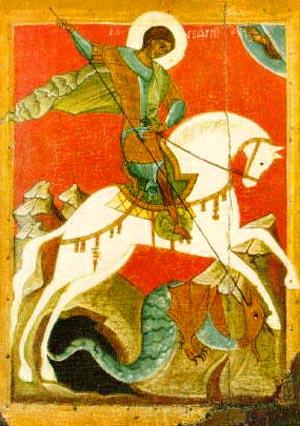
In many Eastern Orthodox countries, Saint George's Day is a big celebration.
Eastern Slavic Traditions
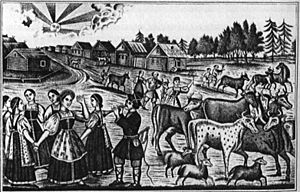
The Russian Orthodox Church has two important days for Saint George. One is on April 23, and another is on December 9. These days are sometimes called Vesenniy Yuriev Den (Yuri's Day in the Spring) and Osenniy Yuriev Den (Yuri's Day in the Fall). Yuri is another form of the name George.
South Slavic and Balkan Traditions
In Serbia, Saint George's Day is called Đurđevdan and is celebrated on May 6. It's a very common family holiday where people celebrate their family patron saint. It's also celebrated by Romani and Gorani people. People often have picnics, music, and folk dances.
In Bulgaria, Saint George's Day (Гергьовден, Gergyovden) is a public holiday on May 6. A common tradition is to prepare and eat a whole lamb. This day is also the Bulgarian Armed Forces Day, with parades in cities like Sofia.
In the Greek Orthodox Church, Saint George's Day is on April 23. If it falls during a religious fasting period or Holy Week, it is moved to the day after Easter. This is because Saint George is a very important saint, and people want to celebrate him fully.
The Georgian Church celebrates Saint George twice a year: on November 23 and May 6. These celebrations might have started as early as the 4th or 5th century.
Middle East Celebrations
Saint George is very important in the Middle East. His worship as a martyr started in Palestine. A church dedicated to him was built in Lydda around the 4th century.
Christians in the Middle East still celebrate Saint George's Day. Muslims also honor him, often connecting him with a figure called Al-Khidr.
In Palestinian culture, the feast is on May 5. It's celebrated in the town of al-Khader, near Bethlehem. People from nearby towns march in a procession to the Monastery of Saint George.
Saint George's Day is also celebrated in Jordan, especially in the town of Fuheis, and in Iraq and Lebanon. Many churches in these countries are named after Saint George. In Syria, many Christian groups celebrate Saint George's Day, especially in the Homs area.
Saint George in Stories
Saint George has appeared in many stories and plays.
In the famous 1897 book Dracula by Bram Stoker, it is said that bad things happen on the night before Saint George's Day. The book mentions May 5 as the date, which was Saint George's Day for Eastern Orthodox churches at that time. The idea is that evil creatures become very powerful between midnight and dawn on this night.
The 1961 play Andorra by Max Frisch is set during the fictional Andorran celebrations of Saint George's Day.
The 2009 play Jerusalem by Jez Butterworth also takes place on Saint George's Day, April 23. This is also the day William Shakespeare is believed to have been born and died.
A recent story called St George's Day by Lee Sheridan is about a student who starts to see connections between his own life and the story of Saint George.
Images for kids
-
A St. George's Day Scouts parade in Somerset, England.
See also
 In Spanish: Día de San Jorge para niños
In Spanish: Día de San Jorge para niños


